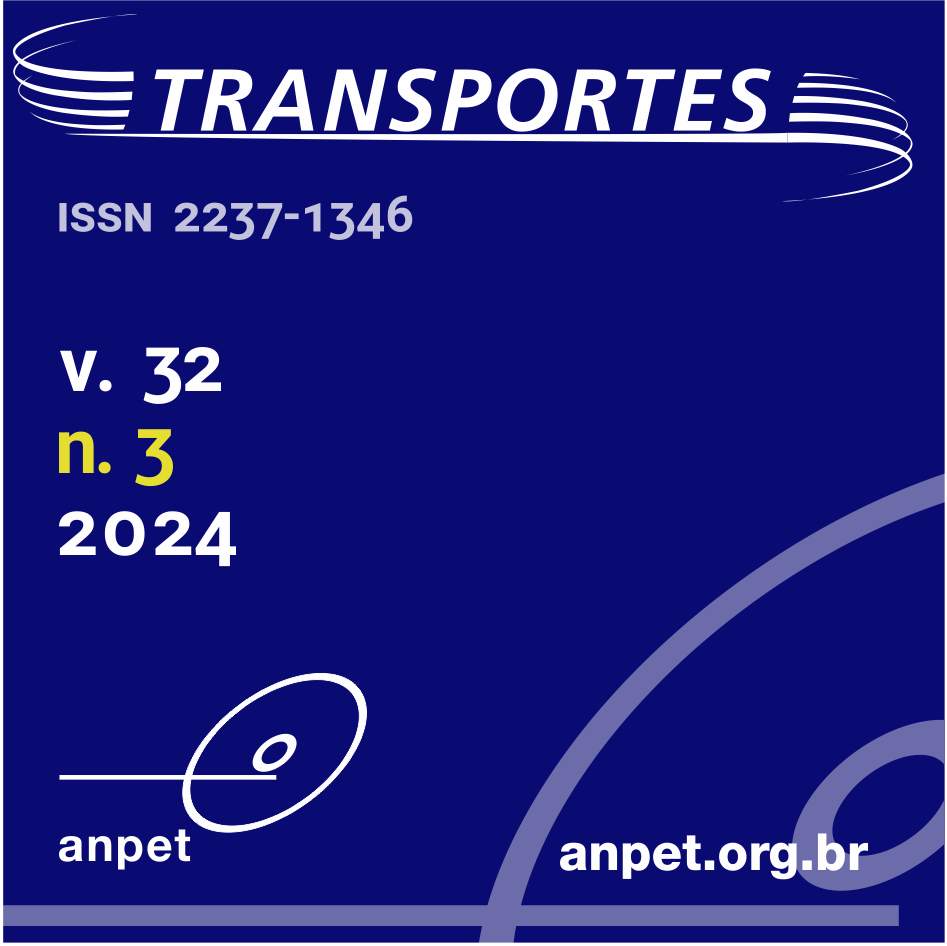Customização e aplicação de ferramenta para coleta automatizada de dados de travessia de pedestres em interseções semaforizadas
DOI:
https://doi.org/10.58922/transportes.v32i3.2961Palavras-chave:
YOLO. Visão computacional. Interseções semaforizadas. Transporte ativo.Resumo
A travessia de pedestres durante o verde veicular é um problema que ainda necessita de maior compreensão e investigação, visto a complexidade das variáveis envolvidas e suas inter-relações. Ferramentas de coleta automatizada podem ser importantes aliadas na obtenção dessas variáveis e análise de suas inter-relações. O objetivo principal deste estudo é customizar e aplicar uma ferramenta automatizada para coletar variáveis importantes em estudos de travessias de pedestres em interseções semaforizadas, sendo estas os headways veiculares, os atrasos dos pedestres, as velocidades veiculares, os tipos de veículo e os instantes de travessia, por faixa. A ferramenta, aplicada em um vídeo de uma interseção semaforizada de Fortaleza, consistiu nas ferramentas YOLOv7 e StrongSORT. O mAP de treinamento da ferramenta foi de quase 90%. Ao todo, 9427 veículos e 723 pedestres foram rastreados; os headways mostraram grande amplitude, a velocidade média dos veículos foi de 28 km/h e o atraso médio dos pedestres foi de 18 seg. A validação com uma ferramenta de coleta (RUBA) apontou que não houve diferenças significativas nas coletas pelos dois métodos quanto aos instantes de passagem dos veículos e de seus headways; para as velocidades veiculares as diferenças foram entre ± 6 km/h, e para as variáveis dos pedestres, as médias das diferenças foram de até 0,2 seg.
Downloads
Referências
Afshari, A.; E. Ayati and M. Barakchi (2021) Evaluating the effects of external factors on pedestrian violations at signalized intersections (a case study of Mashhad, Iran). IATSS Research, v. 45, n. 2, p. 234-240. DOI: 10.1016/j.iatssr.2020.10.004. DOI: https://doi.org/10.1016/j.iatssr.2020.10.004
Al-qaness, M.A.A.; A.A. Abbasi; H. Fan et al. (2021) An improved YOLO-based road traffic monitoring system. Computing, v. 103, n. 2, p. 211-230. DOI: 10.1007/s00607-020-00869-8. DOI: https://doi.org/10.1007/s00607-020-00869-8
Bewley, A.; Z. Ge; L. Ott et al. (2016). Simple online and realtime tracking. In 2016 IEEE International Conference on Image Processing (ICIP). New York: IEEE, p. 3464-3468. DOI: 10.1109/ICIP.2016.7533003. DOI: https://doi.org/10.1109/ICIP.2016.7533003
Bochkovskiy, A.; C.-Y. Wang and H.-Y.M. Liao (2020). YOLOv4: optimal speed and accuracy of object detection. ArXiv. DOI: 10.48550/ arXiv.2004.10934.
Castro Jr., F.A.B.; M.M. Castro-Neto and F.J.C. Cunto (2023) Análise do atraso e da brecha aceita dos pedestres em travessias semaforizadas: um estudo na cidade de Fortaleza utilizando técnicas de visão computacional baseadas em deep learning. Transportes, v. 31, n. 2, e2845. DOI: 10.58922/transportes.v31i2.2845. DOI: https://doi.org/10.58922/transportes.v31i2.2845
Chandra, S.; R. Rastogi and V.R. Das (2014) Descriptive and parametric analysis of pedestrian gap acceptance in mixed traffic conditions. KSCE Journal of Civil Engineering, v. 18, n. 1, p. 284-293. DOI: 10.1007/s12205-014-0363-z. DOI: https://doi.org/10.1007/s12205-014-0363-z
Dhoke, A.; A. Kumar and I. Ghosh (2021) Hazard-based duration approach to pedestrian crossing behavior at signalized intersections. Transportation Research Record: Journal of the Transportation Research Board, v. 2675, n. 9, p. 519. DOI: 10.1177/03611981211003102. DOI: https://doi.org/10.1177/03611981211003102
Dommes, A.; M.A. Granié; M.S. Cloutier et al. (2015) Red light violations by adult pedestrians and other safety-related behaviors at signalized crosswalks. Accident; Analysis and Prevention, v. 80, p. 67-75. DOI: 10.1016/j.aap.2015.04.002. PMid:25884542. DOI: https://doi.org/10.1016/j.aap.2015.04.002
Du, Y.; Z. Zhao; Y. Song et al. (2023) StrongSORT: make DeepSORT great again. IEEE Transactions on Multimedia, v. 25, p. 8725- 8737. DOI: 10.1109/TMM.2023.3240881. DOI: https://doi.org/10.1109/TMM.2023.3240881
Genç, B. and H. Tunc (2019) Optimal training and test sets design for machine learning. Turkish Journal of Electrical Engineering and Computer Sciences, v. 27, n. 2, p. 1534-1545. DOI: 10.3906/elk-1807-212. DOI: https://doi.org/10.3906/elk-1807-212
Koh, P.P. and Y.D. Wong (2014) Gap acceptance of violators at signalized pedestrian crossings. Accident; Analysis and Prevention, v. 62, p. 178-185. DOI: 10.1016/j.aap.2013.09.020. PMid:24172084. DOI: https://doi.org/10.1016/j.aap.2013.09.020
Leal-Taixé, L.; A. Milan; I. Reid et al. (2015). MOTChallenge 2015: towards a benchmark for multi-target tracking. ArXiv. DOI: 10.48550/arXiv.1504.01942.
Luo, W.; J. Xing; A. Milan et al. (2022). Multiple object tracking: a literature review. ArXiv. DOI: 10.48550/arXiv.1409.7618. DOI: https://doi.org/10.1016/j.artint.2020.103448
Ma, Y.; S. Lu and Y. Zhang (2020) Analysis on illegal crossing behavior of pedestrians at signalized intersections based on Bayesian network. Journal of Advanced Transportation, v. 2020, p. 1-14. DOI: 10.1155/2020/2675197. DOI: https://doi.org/10.1155/2020/2675197
Marisamynathan, S. and P. Vedagiri (2019) Pedestrian perception-based level-of-service model at signalized intersection crosswalks. Journal of Modern Transportation, v. 27, n. 4, p. 266-281. DOI: 10.1007/s40534-019-00196-5. DOI: https://doi.org/10.1007/s40534-019-00196-5
Mukherjee, D. and S. Mitra (2022) What affects pedestrian crossing difficulty at urban intersections in a developing country. IATSS Research, v. 46, n. 4, p. 586-601. DOI: 10.1016/j.iatssr.2022.10.002. DOI: https://doi.org/10.1016/j.iatssr.2022.10.002
Nikolaou, D.; A. Ntontis; E. Michelaraki et al. (2023) Pedestrian safety attitudes and self-declared behavior in Greece. IATSS Research, v. 47, n. 1, p. 14-24. DOI: 10.1016/j.iatssr.2022.12.002. DOI: https://doi.org/10.1016/j.iatssr.2022.12.002
Noh, B.; H. Park; S. Lee et al. (2022) Vision-based pedestrian’s crossing risky behavior extraction and analysis for intelligent mobility safety system. Sensors, v. 22, n. 9, p. 3451. DOI: 10.3390/s22093451. PMid:35591139. DOI: https://doi.org/10.3390/s22093451
Onelcin, P. and Y. Alver (2015) Illegal crossing behavior of pedestrians at signalized intersections: factors affecting the gap acceptance. Transportation Research Part F: Traffic Psychology and Behaviour, v. 31, p. 124-132. DOI: 10.1016/j.trf.2015.04.007. DOI: https://doi.org/10.1016/j.trf.2015.04.007
Onelcin, P. and Y. Alver (2017) The crossing speed and safety margin of pedestrians at signalized intersections. Transportation Research Procedia, v. 22, p. 3-12. DOI: 10.1016/j.trpro.2017.03.002. DOI: https://doi.org/10.1016/j.trpro.2017.03.002
Padilla, R.; S. Netto and E.A.B. Silva (2020). A survey on performance metrics for object-detection algorithms. In Proceedings of the International Conference on Systems, Signals, and Image Processing (IWSSIP). New York: IEEE. DOI: 10.1109/ IWSSIP48289.2020.9145130. DOI: https://doi.org/10.1109/IWSSIP48289.2020.9145130
Raoniar, R. and A.K. Maurya (2022) Pedestrian red-light violation at signalized intersection crosswalks: Influence of social and non-social factors. Safety Science, v. 147, p. 105583. DOI: 10.1016/j.ssci.2021.105583. DOI: https://doi.org/10.1016/j.ssci.2021.105583
Redmon, J. and A. Farhadi (2016) YOLOv3: an incremental improvement. ArXiv. DOI: 10.48550/arXiv.1804.02767.
Redmon, J.; S. Divvala; R. Girshick et al. (2016) You only look once: unified, real-time object detection. ArXiv. DOI: 10.48550/ arXiv.1506.02640. DOI: https://doi.org/10.1109/CVPR.2016.91
Sayed, T.; M. Zaki and A. Tageldin (2016). Automated pedestrians data collection using computer vision. In: Leon-Garcia, A. (ed.) Smart City 360°. Lecture Notes of the Institute for Computer Sciences, Social Informatics and Telecommunications Engineering. Cham: Springer International Publishing, v. 166, p. 31-43. DOI: 10.1007/978-3-319-33681-7_3. DOI: https://doi.org/10.1007/978-3-319-33681-7_3
Song, Y.; J. Wang and X. Long (2019) Analysis and modeling of pedestrian crossing behavior at intersections. In 19th International Conference of Transportation. Reston: ASCE, p. 6083-6093. DOI: 10.1061/9780784482292.522. DOI: https://doi.org/10.1061/9780784482292.522
Tonning, C.; T.K.O. Madsen; C.H. Bahnsen et al. (2017) Road user behavior analyzes based on video detections: Status and best practice examples from the RUBA software. In Proceedings of the 24th ITS World Congress. Dubai: ITS World, p. 1-10.
Ultralytics (2023) YOLOv8 Documentation. Available at: <https://docs.ultralytics.com/> (accessed 10/12/2023).
Wang, C.-Y.; A. Bochkovskiy and H.-Y.M. Liao (2022) YOLOv7: Trainable bag-of-freebies sets new state-of-the-art for real-time object detectors. ArXiv. DOI: 10.48550/arXiv.2207.02696. DOI: https://doi.org/10.1109/CVPR52729.2023.00721
Wojke, N.; A. Bewley and D. Paulus (2017) Simple online and realtime tracking with a deep association metric. In IEEE International Conference on Image Processing (ICIP). New York: IEEE, p. 3645-3649. DOI: 10.1109/ICIP.2017.8296962. DOI: https://doi.org/10.1109/ICIP.2017.8296962
Zhu, D.; N.N. Sze and L. Bai (2021) Roles of personal and environmental factors in the red-light running propensity of pedestrians: case study at the urban crosswalks. Transportation Research Part F: Traffic Psychology and Behaviour, v. 76, p. 47-58. DOI: 10.1016/j.trf.2020.11.001. DOI: https://doi.org/10.1016/j.trf.2020.11.001
Downloads
Publicado
Como Citar
Edição
Seção
Licença
Copyright (c) 2024 Juliana de Abreu e Trez, Cornélio Albuquerque de Sousa, Alessandro Macêdo de Araújo, Manoel Mendonça de Castro Neto

Este trabalho está licenciado sob uma licença Creative Commons Attribution 4.0 International License.
Ao submeter um manuscrito para publicação neste periódico, todos os seus autores concordam, antecipada e irrestritamente, com os seguintes termos:
- Os autores mantém os direitos autorais e concedem à Transportes o direito de primeira publicação do manuscrito, sem nenhum ônus financeiro, e abrem mão de qualquer outra remuneração pela sua publicação pela ANPET.
- Ao ser publicado pela Transportes, o manuscrito fica automaticamente licenciado sob a Licença Creative Commons CC BY 4.0. Esta licença permite o seu compartilhamento com reconhecimento da autoria e da publicação inicial neste periódico.
- Os autores têm autorização para assumir contratos adicionais separadamente, para distribuição não exclusiva da versão do trabalho publicada neste periódico (por ex.: publicar em repositório institucional ou como capítulo de livro), com reconhecimento da publicação inicial na Transportes, desde que tal contrato não implique num endosso do conteúdo do manuscrito ou do novo veículo pela ANPET.
- Os autores têm permissão e são estimulados a publicar e distribuir seu manuscrito online (por ex.: em repositórios institucionais ou na sua página pessoal) depois de concluído o processo editorial. Como a Transportes é de acesso livre, os autores são estimulados a usar links para o DOI do artigo nesses casos.
- Os autores garantem ter obtido a devida autorização dos seus empregadores para a transferência dos direitos nos termos deste acordo, caso esses empregadores possuam algum direito autoral sobre o manuscrito. Além disso, os autores assumem toda e qualquer responsabilidade sobre possíveis infrações ao direito autoral desses empregadores, isentando a ANPET e a Transportes de toda e qualquer responsabilidade neste sentido.
- Os autores assumem toda responsabilidade sobre o conteúdo do manuscrito, incluindo as devidas e necessárias autorizações para divulgação de dados coletados e resultados obtidos, isentando a ANPET e a Transportes de toda e qualquer responsabilidade neste sentido.









